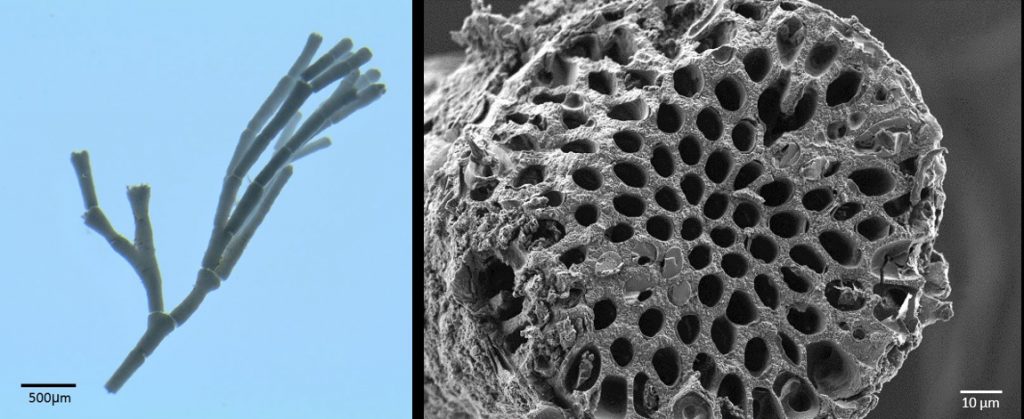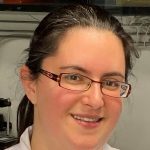Flexible, Durable Algae Inspirations
Resilience of Coralline Red Algae Inspires Man-made Materials and Structures
Coralline red alga is characterized by a combination of flexibility and durability. New findings on its structure by researchers at the Technion have shed light on what in its unique structure gives mineralized coralline red alga its remarkable resilience within strong sea currents. Such insight into nature’s designs can be used to develop new low‐weight, high‐compliance structures.
Prof. Boaz Pokroy and PhD student Nuphar Bianco‐Stein from the Department of Materials Science and Engineering have uncovered the unique structure of the articulated coralline red alga Jania sp., a type of sea plant. The research was published in the journal of Advanced Science.
Coralline red algae (phylum Rhodophyta) are widespread throughout the world’s oceans and seas, where they play an important role in coral reef ecology. One main group, articulated coralline red algae, grows upright in an anchored branched structure which must endure stress from strong waves and currents. Its durability is based on a unique micrometric structure that combines great flexibility with strength. In the present study, the team sought to uncover the unique structure of Jania sp. and how its structure embodies both strength and flexibility.
In recent years, Prof. Pokroy’s research has focused on biomineralization – a process in which living things form minerals. Through controlled biomineralization, various forms of life create complex structures to serve their own needs. The present study focuses on the biomineralization of Mg-calcite (Magnesium – calcite) in algae.
Calcite, which is a very stable version of calcium carbonate, is a very common ingredient in the skeletal parts of many sea creatures, giving them their hard exoskeleton. Man can make artificial calcite, but nature-produced calcite is characterized by complex and unique forms that give it high durability and other unique features.
In a previous study on these algae, the researchers found that the uncalcified joints that connect the calcified segments of articulated coralline red algae, give the algae flexibility to endure outer stresses from waves. In the current study, the researchers studied the calcified segments of Jania sp. from the macroscale to the nanoscale at the ESRF Synchrotron in Grenoble, France.
The ESFR Synchrotron is an 844-meter circular particle accelerator, and it is the world’s strongest synchrotron in terms of the light intensity it produces; with the ability, for example, to produce X-rays that are 100 billion times stronger than an X-ray in a hospital.
Through chemical analysis and confirmed using high resolution powder X‐ray diffraction (XRD) using the synchrotron radiation, the researchers discovered that the calcite that the coralline red algae secretes and crystalizes on an organic framework as part of its skeleton, contains a large amount of high-Mg Calcite.
High‐resolution scanning electron microscopy (HRSEM) of the alga’s cross section, revealed a highly porous structure (as high as 64% of its volume). This porosity enhances the algae’s strength per weight. Moreover, the microstructure of the porous crystalized Mg Calcite is not random: Higher resolution X‐ray nanotomography of Jania sp., performed at the ESRF’s ID16B beamline, demonstrated that the microstructure of high‐Mg calcite is helical, rather than cylindrical. The pores spiral in a helical structure! This is the first known report of such a helical structure in these types of algae. Using a finite element analysis model, the team showed that the helical nature of the red algae increases their compliance and therefore their resilience to the outer stresses they experience underwater.
“This coil shape,” said Prof. Pokroy, “increases the resilience of flexural bending by up to 20%. We hope that, based on these findings, we can use innovative methods to produce artificial materials with similar properties – coil pores – which will be as light, flexible, and strong as the skeleton of Jania sp.”
The group concluded that it is the combination of high porosity and a helical configuration that gives Jania sp. it’s sophisticated, lightweight, compliant structure. It is anticipated that these findings will be of value for future design of manmade lightweight structures with superior mechanical properties.
Prof. Pokroy is a member of the Scientific Advisory Board of the ESRF the European Synchrotron Radiation Facility – Grenoble, and he emphasizes that the current research relies on many years of collaboration with the Synchrotron in Grenoble.
Click here for the paper in Advanced Science





